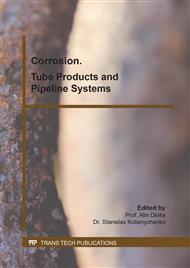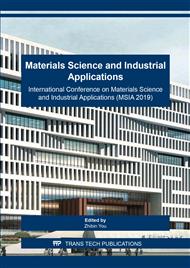p.15
p.21
p.26
p.32
p.39
p.47
p.53
p.59
p.65
Pitting Corrosion Failure Analysis of a Produced Oil/Water Fluid Pipeline
Abstract:
This paper presents corrosion failure analysis of an underground natural gas pipeline. The pipeline material grade is 20# steel. The pipeline transfers multiphase fluid (Crude oil and water) from an oil well to an oil gathering plant. A portion of the line failed due to pitting corrosion under unknown circumstances. Scanning electron microscopy (SEM) and X-ray diffraction (XRD) are employed to characterize the scales and/or corrosion products near the failed portion. Based on visual and microscopic analyses and reviewing the background information, the following pitting corrosion sequences were identified: When the water ratio was smaller than 50%, the oil slick could cover the surface of the 20# test samples. Some uncovered surface would be corroded. When the water ratio was more than 70%, the surface of 20# steel contacted with more water. The average corrosion rate increased, and the corrosion products also formed, which would behave as a good diffusion barrier to prevent the underlying steel from further dissolution. Meanwhile, because of the corrosion products, the penetration rate also increased, the trend of local corrosion became weak with the water ratio continued to increase. The pitting corrosion varied with the water ratio because of the protection conferred by the oil slick or the corrosion product layer. Under such conditions, pits emerged on the steel surface until one of them grew faster and failed the oil pipeline.
Info:
Periodical:
Pages:
39-44
Citation:
Online since:
May 2019
Authors:
Keywords:
Price:
Сopyright:
© 2019 Trans Tech Publications Ltd. All Rights Reserved
Share:
Citation:



